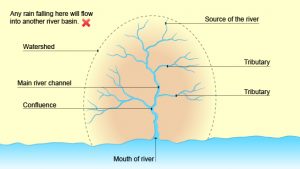ID# 5126
| 1. | Where Does Water Come From?Water is
Water exists【存在】 in three states【狀態】: ice(solid【固體】), water(liquid【液體】) and water vapour(gas). The movement of water is driven by the energy of the sun. Water changes from one state【狀態】 to the other between the atmosphere【大氣層】, the land, and the sea continuously【一直地】. Water Cycle
 A river basin【河盆】, also known as drainage basin, is the area of land drained by a river and its tributaries【支流】. A watershed【分水嶺】, usually a highland or a ridge【山脊】 is an imaginary【假想】 line that separates【分隔】 two neighbouring【相鄰】 river basins.
The Amazon River Basin【亞馬遜河盆】 in South America is the largest river basin in the world. A mature【成熟】 river consists of【由......組成】 three sections – the upper course【上游】, the middle course【中游】 and the lower course【下游】. | ||||||
| 2. | What Is The Global Distribution Pattern Of Water Resources?Water resources【水資源】 refer to the freshwater【淡水】 that is readily available【可用的 】 for human use. Freshwater accounts for 3% the world’s total water, most of it is frozen【冰封】 or stored underground.
The distribution of freshwater is uneven in the world. Normally, places with higher rainfall often have more freshwater resources. However, having more freshwater resources does not mean having a secure water supply. It is because the amount of water available for use is also affected by the size of population.
The world’s water supply is threatened【威脅】 by
|
